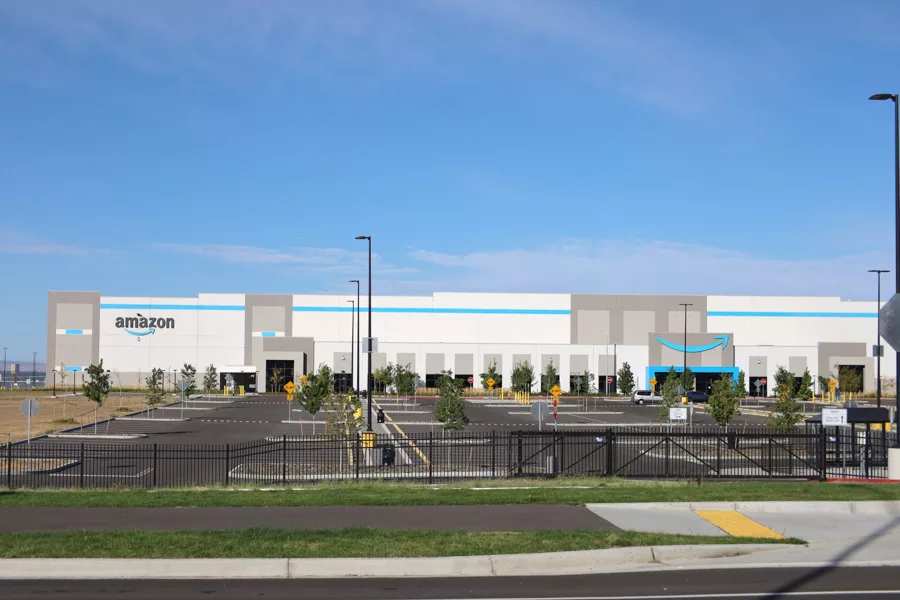
Home » Pent-up market sprints toward strong finish
Commercial Real Estate
Pent-up market sprints toward strong finish

One of the two massive Amazon warehouses along South Road 40 East in Pasco, north of Sacajawea State Park.
Photo by Nathan FinkeOctober 14, 2024
Commercial real estate in the Tri-Cities has been steady on the construction side this year, fueled by large industrial projects as well as development on flex spaces and new offices.
But although construction is steady, the real estate market has been moving a little slower, said Derrick Stricker, designated broker and owner of Stricker CRE in Kennewick. Despite plenty of interest in commercial properties, there have been fewer transactions this year.
Uncertainty, especially in terms of financing, has led to more leasing than buying, he said, and the leases are trending toward shorter lengths, such as two to three years rather than five.
“We’re seeing kind of the pent-up market that wants to buy, believes our market is strong, but with a lot of financing changes, it’s making things not able to be penciled,” Stricker said.
Market challenges
Financing difficulties, along with other uncertainties, have been hitting real estate hard, Stricker said, and “not just the first-timers.”
With new energy codes put in place, clients, contractors and others are now finding out how much things cost. “It’s led to more time delay, less deals getting done,” Stricker said.
“It’s just taking longer to get the results,” he said. “We’re still getting results. We’re not getting the same intensity of them, but we have a lot of great things that are coming to the market, opportunity-wise.”
An election year also has the potential to cause difficulties.
“What we’re watching for is, will there be more regulation that drives up the cost of construction, that delays timeline?” said Joel Bouchey, regional director of the Inland Northwest Associated General Contractors.
Upcoming changes could dictate whether the construction industry continues as is or needs to slow down.
For construction, financing has been less of an issue, Bouchey said. People have adapted to higher interest rates for the most part.
“There’s still sometimes some sticker shock … but ultimately it seems that it isn’t stopping every project,” he said.
The construction industry’s challenges lie more on the workforce side. With an older demographic in the industry, “we are always looking for more workforce,” Bouchey said, including in managerial roles.
Insulated area
Despite financial and other challenges, there is also reason to be optimistic about the state of commercial real estate.
The region is often insulated from some of the trends seen across the nation, thanks to the influx of federal dollars related to the Hanford cleanup and Pacific Northwest National Laboratory in Richland.
“We continue to have kind of that insulated market where things just seem to continue moving forward,” Bouchey said.
One example of that insulation turns up in office vacancies. Stricker said that due to the lack of office supply inventory, the Tri-Cities hasn’t had the same issues with vacancies as the rest of the country.
The national vacancy rate was 18.1%, according to an August report on the office market by CommercialEdge. That’s an increase from the same month in 2023, when the rate was 17.1%, and 2022 saw a rate of 15.2%.
But in the Tri-Cities, it seems, “we’re full. We need more,” Stricker said. He’s seen lots of new office developments.
The Badger Mountain South area off Dallas Road has been seeing a lot of commercial interest, according to Stricker. “It’s been coming for years that way,” he said. The area has infrastructure already in place in addition to the availability of land. The pricing, Stricker said, is also affordable for the Tri-Cities market.
“Queensgate remains busy ... because retail is very strong, it’s a busy corridor,” he said. “You have the Costco (and state Department of Natural Resources) deal that’s maybe almost done, so this continues to nail that area as a strong investment area.”
Another area to watch is west Pasco, by Broadmoor and Road 100, Stricker said.
Industry interests
Not only are certain areas of the Tri-Cities garnering lots of attention, but certain industries are as well.
Construction in the industrial sector has been particularly hot, Bouchey said, “fueled somewhat by the mega projects we’ve had, like Darigold and Amazon.” He expects projects like Rockwool and Atlas Agro to have a big impact as well.
“Those are some huge construction projects that are going to take advantage of a good chunk of our local contractors to do work on,” Bouchey said.
Just this year, Darigold submitted a $67 million permit for a new commercial facility at 8201 N. Railroad Ave., Pasco, the highest-priced permit since the beginning of 2024. And Amazon, using the name Project Oyster Pasco LLC, spent $10 million on tenant improvements this year at 1351 S. Road 40 East.
Stricker, too, observed an interest in industrial assets. He described it as a “giant industrial boom.”
In his view, there aren’t enough facilities to meet a nationwide industrial demand. While there’s plenty of land, Stricker sees a vulnerability in not having industrial spaces ready to go.
Just after industrial properties in terms of activity is agricultural construction, Bouchey said, and office spaces – both new construction and renovations – are doing well, too.
He pegs retail and food service as the slowest market for construction. However, “we’ve had several auto dealers recently build new spaces, move to larger spaces, relocate to a better, more visual space.”
Going forward
The outlook going forward remains a fairly positive one.
“In the next 12 months, I think we’re going to be cruising just fine,” Bouchey said. He was optimistic and didn’t anticipate a major economic downturn.
He hoped for a balance between residential, commercial and government work. Five or six years ago, Bouchey said, there was an excess of demand on all fronts for a few years. Now, it’s gone back to a more normal cycle.
And the supply chain issues the industry has seen have largely been resolved. Now, only specialty lines, such as commercial kitchen equipment, continue to be challenging.
Stricker anticipated that the commercial real estate market would see a big push toward the end of the year.
With fewer transactions and lots of quality assets on the market, he expected deals to start closing in the last quarter of 2024 and into 2025. Once an initial move is made, it will trigger other vacancies filling up, Stricker said.
“I’m still optimistic,” he said. “If we’re in a softness or a downturn or a pause, I still believe in great locations, great properties and buying stuff at the right economics.”
Construction + Real Estate
KEYWORDS October 2024





